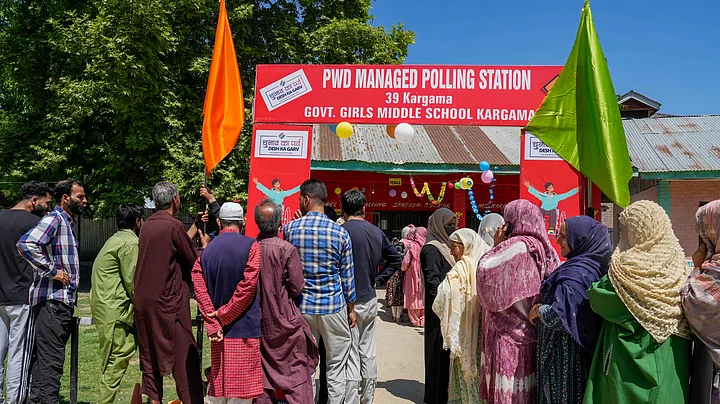Trends on the electoral stage indicate that the ruling establishment’s strategy with regard to Jammu and Kashmir has switched. It is difficult to understand why.
For most of the past five years, there was an all-out effort to suppress, jail, or at least marginalise those who had taken separatist positions in the past. But some of those are now springing back to the political centre stage.
Jamaat-e-Islami’s recent announcement that it will directly contest assembly elections caused eyebrows to be raised. For, since the constitutional changes of 2019, the administration has gone after Jamaat in particular, summarily sacking and transferring government employees with Jamaat connections. Even non-Jamaat relatives of those who had been the leading lights of Jamaat in the past were not spared.
If Jamaat leaders got a signal from Home Minister Amit Shah during his recent visit to the union territory, or from others in the state apparatus, that the ban on JeI would be lifted, it would represent an amazing turnaround.
'Tihar Ka Jawab Vote Se': Slogans Heard Loud
The vigorous campaign of ‘Engineer’ Rashid, who has used strongly anti-state language and is indeed contesting from jail, is another intriguing factor. Remarkably in a place which is quite tightly controlled, his sons and other supporters were allowed to campaign widely, including the prominent locations.
Campaign slogans such as ‘Tihar ka jawab vote se’ (the answer to jail should be exercised through a vote) excited emotions. His sons pleaded with voters that an electoral victory would ensure their father’s release from the horrors of incarceration.
Rashid, therefore, became a strong third pole in the fight for the Baramulla constituency in North Kashmir, voting for which happened a few days ago. His competitors in the largely triangular contest were National Conference Vice-President, Omar Abdullah, and People’s Conference Chief, Sajad Lone. Abdullah ought to win, but so vigorous was Rashid’s campaign even in his absence that some observers think he may come out ahead.
While freedom for his campaign is a plus for the country’s democratic record, Rashid’s campaign, led by his sons, has ignited anti-Indian sentiments in many youth and may have sown the seeds of future conflict. Rashid gained immense traction during the 2019 Lok Sabha election campaign too. He was then supported by IAS officer Shah Faesal, who was later posted in the National Security Council Secretariat (NSCS).
Politically, Rashid’s campaign seems to have prevented the vote shares of both Abdullah and Lone from expanding much beyond their traditional voters. What’s really intriguing is the voting patterns among backers of some prominent politicians with strong influence in single assembly constituencies and ties to some wings of the state apparatus. Some observers suspect that Rashid gained significant chunks of their loyalists’ votes.
Rashid may also have drawn the votes of many youths in Beerwah, Abdullah’s erstwhile assembly constituency. He certainly gained several votes in Sopore, that longstanding bastion of rebelliousness, and in Palhalan.
Officers such as Shabih Naqvi, TM Pattnaik and Alok Dash, who held charge of the nearby 10 Sector of Rashtriya Rifles when they had the rank of Brigadier, deserve kudos for curing the alienation of stone-pelters in this area.
The Shia Factor In Play
However, Palhalan’s turnout has changed the likely outcome for the Pattan region overall. This is because most of the votes from this region have likely gone to Lone’s rivals in the fray, with older residents backing Abdullah, and younger ones preferring ‘Engineer.’
As long as the Palhalan belt boycotted polls, the votes of the large Shia population of the area prevailed and most of them voted for whoever was backed by Imran Ansari, a key colleague of Lone. However, this influence has been hobbled by the fact that Shia leader, Agha Rohullah, is the National Conference candidate for the Srinagar seat.
Rohullah’s own home belt in Budgam has been shifted from Srinagar to the Baramulla constituency. Many traditional Ansari backers in other parts of North Kashmir have chosen to back the National Conference as a gesture of thanks for sending a Shia to the Lok Sabha.
The upshot of all this is that, despite support from the home minister, and from key persons in the administration, Lone’s votes have mainly been limited to his and his colleagues’ strongholds that includes his native Kupwara district, Uri, the Kandi region between Baramulla and Gulmarg, and possibly Pattan, Bandipora, and Tangmarg.
Even in the Kupwara district, both his main rivals are likely to have taken substantial chunks of votes, except in the Pahadi-dominated Karnah sub-district.
In Kashmir, some of the most important trends tend to be subterranean. These trends could have a significant impact on assembly elections, which are likely to happen in a few months, and possibly on the stability of the place.
(The writer is the author of ‘The Story of Kashmir’ and ‘The Generation of Rage in Kashmir’. He can be reached at @david_devadas. This is an opinion piece and the views expressed above are the author’s own. The Quint neither endorses nor is responsible for the same.)
(At The Quint, we question everything. Play an active role in shaping our journalism by becoming a member today.)
